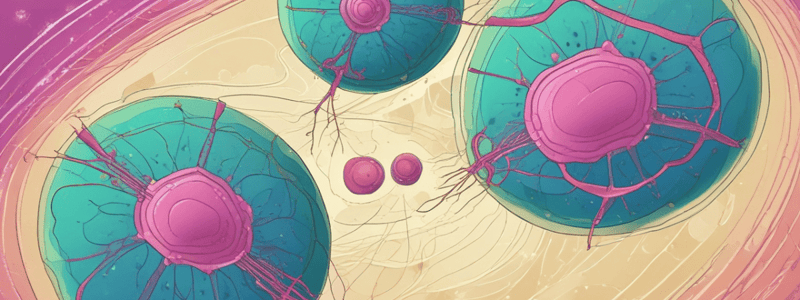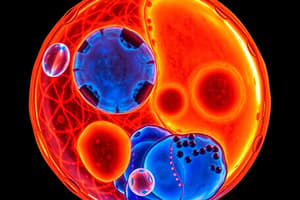Podcast
Questions and Answers
What is the complex of DNA and proteins referred to as?
What is the complex of DNA and proteins referred to as?
- Centromere
- Nucleosome
- Telomere
- Chromatin (correct)
What forms when DNA slightly coils around histones?
What forms when DNA slightly coils around histones?
- Chromatin
- Chromosome
- Centrosome
- Nucleosome (correct)
Which structures assist in organizing the DNA inside the nucleus by forming bead-like units?
Which structures assist in organizing the DNA inside the nucleus by forming bead-like units?
- Histones (correct)
- Lysosomes
- Ribosomes
- Mitochondria
Which phase of the eukaryotic cell cycle involves the synthesis and replication of DNA?
Which phase of the eukaryotic cell cycle involves the synthesis and replication of DNA?
What is the final result of cell division in eukaryotic cells?
What is the final result of cell division in eukaryotic cells?
What are the two main reasons that a cell divides?
What are the two main reasons that a cell divides?
Which factor does NOT affect the rate of exchange of substances in and out of a cell?
Which factor does NOT affect the rate of exchange of substances in and out of a cell?
How does the surface area to volume ratio change as a cell grows larger?
How does the surface area to volume ratio change as a cell grows larger?
What primarily dictates the traffic problems faced by larger cells?
What primarily dictates the traffic problems faced by larger cells?
What role does DNA play in limiting cell size?
What role does DNA play in limiting cell size?
Which stage is characterized by the separation of sister chromatids?
Which stage is characterized by the separation of sister chromatids?
Which structures are responsible for organizing spindle fibers in plant cells?
Which structures are responsible for organizing spindle fibers in plant cells?
What occurs during prophase in eukaryotic cells?
What occurs during prophase in eukaryotic cells?
What is the primary function of the centromere during mitosis?
What is the primary function of the centromere during mitosis?
Which phase of mitosis is typically the longest and may take up half of the total time to complete mitosis?
Which phase of mitosis is typically the longest and may take up half of the total time to complete mitosis?
In which phase do the centromeres of duplicated chromosomes line up across the center of the cell?
In which phase do the centromeres of duplicated chromosomes line up across the center of the cell?
Which structure forms in plant cells during cytokinesis to separate the two daughter cells?
Which structure forms in plant cells during cytokinesis to separate the two daughter cells?
What happens to the cell membrane in animal cells during cytokinesis?
What happens to the cell membrane in animal cells during cytokinesis?
Which regulatory proteins respond to events inside the cell?
Which regulatory proteins respond to events inside the cell?
What role do growth factors play in regulating the cell cycle?
What role do growth factors play in regulating the cell cycle?
How do cells respond to tissue injury in terms of cell division?
How do cells respond to tissue injury in terms of cell division?
What prevents a cell from entering anaphase until spindle fibers have attached to each chromosome?
What prevents a cell from entering anaphase until spindle fibers have attached to each chromosome?
What is an advantage of asexual reproduction?
What is an advantage of asexual reproduction?
Which of the following statements is true about prokaryotic chromosomes?
Which of the following statements is true about prokaryotic chromosomes?
What is a disadvantage of sexual reproduction?
What is a disadvantage of sexual reproduction?
What role do histones play in eukaryotic chromosomes?
What role do histones play in eukaryotic chromosomes?
What is a key consequence of lack of genetic diversity in asexual reproduction?
What is a key consequence of lack of genetic diversity in asexual reproduction?
Which organisms primarily rely on cell division as their only form of reproduction?
Which organisms primarily rely on cell division as their only form of reproduction?
How do offspring produced by sexual reproduction differ from those produced by asexual reproduction?
How do offspring produced by sexual reproduction differ from those produced by asexual reproduction?
Where is the genetic information of prokaryotic cells primarily located?
Where is the genetic information of prokaryotic cells primarily located?
What role does the cell cycle play in the organism?
What role does the cell cycle play in the organism?
Which regulatory influence is particularly associated with the cell cycle?
Which regulatory influence is particularly associated with the cell cycle?
Which mechanism can halt the cell cycle?
Which mechanism can halt the cell cycle?
During wound healing, why is the cell cycle significant?
During wound healing, why is the cell cycle significant?
How do other external regulatory proteins affect the cell cycle?
How do other external regulatory proteins affect the cell cycle?
Which cell type is capable of developing into any type of cell in the body?
Which cell type is capable of developing into any type of cell in the body?
At what developmental stage do human cells begin to specialize?
At what developmental stage do human cells begin to specialize?
What are embryonic stem cells specifically capable of producing?
What are embryonic stem cells specifically capable of producing?
What types of cells do adult stem cells primarily differentiate into?
What types of cells do adult stem cells primarily differentiate into?
Which of the following statements about pluripotent cells is accurate?
Which of the following statements about pluripotent cells is accurate?
In a Punnett square prediction of genotype frequencies for a monohybrid cross between parents with PP and Pp genotypes, what percent of the offspring is expected to be heterozygous?
In a Punnett square prediction of genotype frequencies for a monohybrid cross between parents with PP and Pp genotypes, what percent of the offspring is expected to be heterozygous?
Study Notes
Cell Growth, Division, and Reproduction
- Limits to Cell Size
- Two main reasons for cell division: + Cell becomes less efficient in moving nutrients and waste materials + As a cell grows, it places increasing demands on its own DNA
- Problems of Size
- Rate of exchange between food, oxygen, and water to enter and waste products to leave depends on surface area of cell
- As cell grows, rate of exchange becomes less efficient, leading to cell division
Cell Division and Reproduction
- Asexual
- Cell division is the only form of reproduction for many single-celled organisms
- The two cells produced are genetically identical to the cell that produced them
- Sexual
- Involves fusion of two reproductive cells formed by each of two parents
- Offspring produced by sexual reproduction inherit some genetic information from each parent
Compare
- Asexual
- Advantages
- Can reproduce quickly, enabling them to compete successfully with other organisms
- Disadvantages
- Lack of genetic diversity is a disadvantage when conditions change
- Advantages
- Sexual
- Disadvantages
- Requires more time to find a mate and allows for growth and development of offspring
- Advantages
- Produces genetic diversity
- If the environment changes, diversity in species may help ensure that the population contains the right combination of characteristics needed to survive
- Disadvantages
Process of Cell Division
- Chromosomes
- Genetic information is bundled into packages of DNA called chromosomes
- Prokaryotic Chromosomes
- DNA molecules are found in the cytoplasm
- Most prokaryotes contain a single circular DNA chromosome containing all of the cell's genetic information
- Eukaryotic Chromosomes
- Chromosomes in eukaryotic cells contain DNA tightly bound to proteins known as histones
- The complex of DNA and proteins is referred to as chromatin
The Structure of DNA and Chromosomes
- DNA slightly coils around histones and together the DNA
Cell Division
- G2: Preparing for cell division
- Synthesis phase: Many of the organelles and molecules required for cell division are produced
- M Phase: Cell division
- Mitosis
- Cytokinesis
Mitosis
- 4 phases:
- Prophase:
- Longest phase, may take up to half of total time to complete mitosis
- Genetic material inside nucleus condenses and duplicated chromosomes become visible
- Outside nucleus, spindle starts to form
- Metaphase:
- Centromeres of duplicated chromosomes line up across the center of the cell
- Anaphase:
- Sister chromatids separate and move to opposite ends of the cell
- Telophase
- Prophase:
Cytokinesis
- Division of cytoplasm to form two separate cells
- Usually occurs at the same time as telophase
- In animal cells:
- Cell membrane is drawn inward until cytoplasm is pinched into two nearly equal parts
- In plant cells:
- Cell plate forms halfway between divided nuclei
- Cell plate gradually grows into cell membranes that separate the two daughter cells
Regulating Cell Cycle
- Controls on Cell Division
- Cells at edges of injury are stimulated to divide rapidly
- New cells form, starting the process of healing
- When healing process nears completion, rate of cell division slows, controls on growth are restored, and normal activities return
- Regulatory Proteins
- Dozens of proteins help to regulate
- Cell cycle is controlled by regulatory proteins both inside and outside the cell
Cell Differentiation
- Adult Cells
- Generally reach a point at which their differentiation is complete - cannot turn into other types of cells
- Stem Cells and Development
- Totipotent: Able to develop into any type of cell in the body
- Human Development:
- After about four days of development, human embryo forms into a blastocyst
- At this stage, cells begin to specialize
- Outer cells form tissues that attach embryo to mother
- Inner cells are said to be pluripotent
- Stem Cells
- Sit at base of branching “arm” of development from which different cell types form
- Stem cells are the unspecialized cells from which differentiated cells develop
- Adult Stem Cells
- Pools of adult stem cells produce new cells to replace dead cells
- Limited to replacing cells in the tissues where they are found
- Pools of adult stem cells produce new cells to replace dead cells
- Embryonic Stem Cells
- Capable of producing every cell type
Studying That Suits You
Use AI to generate personalized quizzes and flashcards to suit your learning preferences.
Description
This quiz covers the limitations of cell size, the reasons why cells divide, and the problems associated with increasing cell size.




